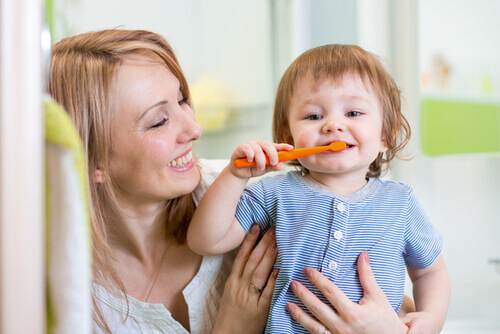Baby's First Teeth: Everything You Need to Know

Generally, your baby’s first teeth will begin to appear at 4 months of age. In some cases, they start coming in at the age of 1 year.
There’s no reason to be alarmed if they take longer to appear, as each baby is different.
In what order do their teeth first appear?
In most babies, the order of appearance of milk teeth aids in the evolution of their diet. The first teeth to appear are the incisors, which are very useful for chewing vegetables and softer foods. Later, the molars and canines appear, which arise to help chew meat.
As we indicated previously, the process of teeth eruption is variable, but it usually ends between 20 and 30 months.
Of course, there may be some exceptions. It should be noted that there are even cases of children being born with a tooth, but this is quite rare.
When babies start to show milk teeth, they may drool more and bite more objects. Some get through the process without any pain, while others experience moments of irritability, as well as episodes of crying and disturbances when sleeping and feeding.
Yes, cavities can develop in baby teeth, and infant cavities are very common.
Teething symptoms
When a baby’s first teeth appear, the symptoms are generally mild and some babies do not seem to notice that their teeth are coming in. In contrast, others may have a fever or diarrhea.
Here are the symptoms to look out for:
- Your baby’s first teeth can be hidden under the gum for weeks at a time, or can pierce the gums suddenly, without any warning.
- When the tooth is about to erupt, the gum changes in appearance, becoming swollen and having a hard, whitish protrusion when touched. It can be painful and annoying for the little one.
- Normally, the eruption of baby teeth is accompanied by slight discomforts, such as a fever and cold symptoms, but diarrhea and irritability can also occur.

How to relieve teething pain
Whatever the age at which the baby’s teeth begin to appear, once they start to erupt, a series of important actions must be taken in order to alleviate teething pain (if there is any).
Here are some recommendations:
- Wrap your finger in some sterile gauze and gently massage the gum. This is a very effective way to relieve the pain caused by teething.
- Another option to alleviate the pain of teething is to rub the gums with a piece of ice, also wrapped in sterile gauze.
- A special hard rubber teether can also be very useful, as it can provide relief for the gums and, thanks to its shapes and colors, can be very attractive to babies, distracting them from the pain.
- There are specific ointments to relieve pain that are anesthetic and natural.
How to clean your baby’s first teeth
Before the first teeth erupt, you can gently clean your baby’s gums from time to time with a damp cloth so that he becomes accustomed to having that area handled.
Once the first teeth appear, continue to clean them with a damp cloth. However, if complementary feeding has already begun, a special small baby brush with very soft bristles can be used.

This is very important after 18 months of age, which is usually when the first molar teeth appear, because food remains can accumulate between the teeth. It is advisable to brush your child’s teeth two to three times a day, especially before going to bed at night.
The European Academy of Pediatric Dentistry recommends brushing twice a day with a specific toothpaste. This cannot be an adult toothpaste due to the risk of fluorosis. Paste for children under two years of age must have a concentration of 500 ppm.
It is important to once again emphasize that each baby is different and their teeth will appear when they are ready. If you have any questions, however, you can consult with your pediatrician or with a dentist.
This text is provided for informational purposes only and does not replace consultation with a professional. If in doubt, consult your specialist.
